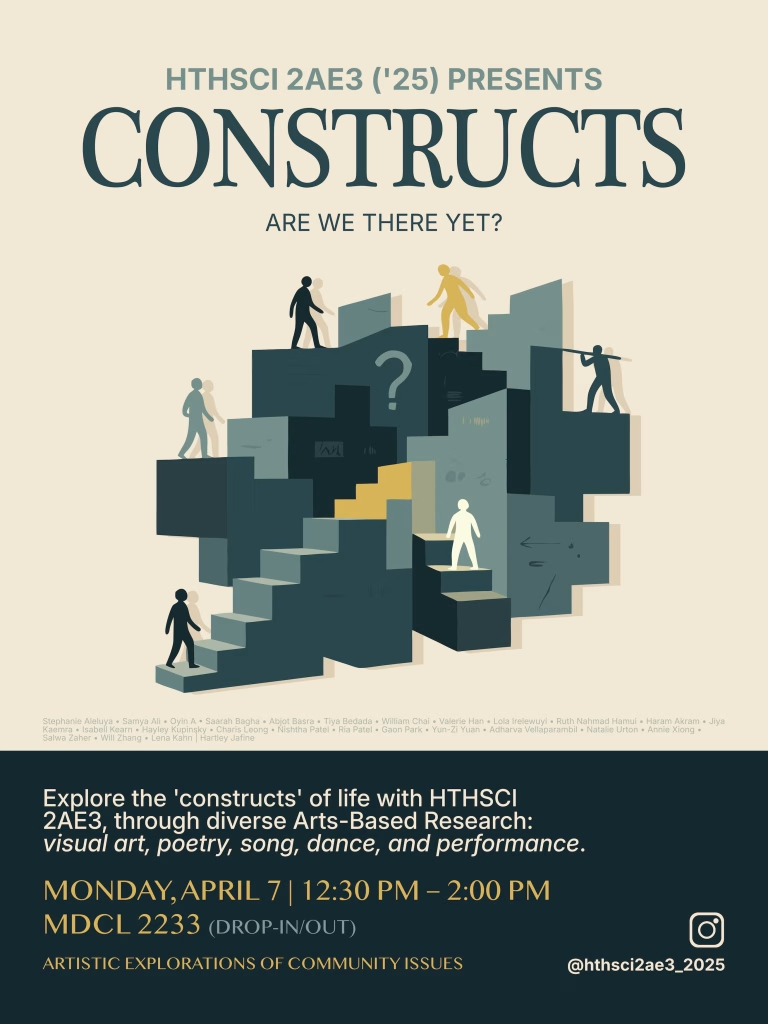Velocity – An Arts-Based Research Exploration
Velocity – An Arts-Based Research Exploration

Velocity
An Arts-Based Research exploration from HTHSCI 2AE3: Artistic Explorations of Community Issues
Photographer: William Chai
Year: 2025
Medium: Digital Photograph
Artist Statement
This photograph uses the technical interaction of shutter speed and flash duration to explore the subjective experience of striving within our community. The motion blur represents the relentless pace and inherent uncertainty of the journey: a velocity that often outpaces our ability to be fully present.
In contrast, the flash freezes fleeting instants, like the sharp snapshots of expectation or achievement we encounter. By capturing this tension between the blur of lived experience and the frozen moment, ‘Velocity’ questions the nature of progress and asks: In our constant forward motion towards ‘there,’ what defines the journey itself?
Further Reflection: Arts-Based Research Context
This photograph, Velocity, was created within the framework of HTHSCI 2AE3: Artistic Explorations of Community Issues, utilizing principles of Arts-Based Research (ABR). ABR employs artistic practice as a primary mode of inquiry and knowledge generation, aiming to explore complex human experiences and community issues in ways that traditional research methods might not fully capture.
“Velocity” as Arts-Based Research:
Inquiry through Metaphor: The work functions as ABR by employing visual metaphor (the interplay between motion blur and flash-frozen moments) to investigate the subjective experience of pressure, pace, and the pursuit of goals within the specific context of the McMaster Health Sciences community. It moves beyond simply documenting an event to exploring the feeling and underlying constructs associated with academic and pre-professional striving.
Provoking Reflection and Dialogue: A core aim of ABR is to evoke response and stimulate dialogue. By presenting a familiar campus scene through the lens of Velocity, the photograph invites viewers to reflect on their own experiences with the “Arrival Fallacy,” societal scripts, and the often-unspoken pressures inherent in navigating demanding academic paths. It seeks to make the familiar visible and open to questioning, aligning with Augusto Boal’s concept of theatre throwing light on the stage of daily life.
Embodied Knowledge & Process: The creation process itself was part of the inquiry. Experimenting with shutter speed, flash, and capturing the physical act of the photographer as the subject, running, was a way to embody and explore the theme of velocity directly. The technical choices were not merely aesthetic but were integral to investigating how photographic techniques could represent the tension between internal feeling (blur) and external perception or milestones (flash).
Integration within the HTHSCI 2AE3 Showcase (“Constructs”):

The showcase theme revolved around exploring the “constructs” – societal, communal, personal – that shape our journeys, often framed by the question, “Are We There Yet?”. “Velocity” engages directly with this by:
Visualizing the ‘Constructs’ in Motion: The photograph depicts navigating the physical and symbolic constructs of the university environment (the path, the buildings, the professional attire) but emphasizes the experience of that navigation – the speed, the blur, the fragmented moments of clarity.
Challenging Linear Narratives: It implicitly questions the linear “laying tracks” metaphor discussed in class by presenting the journey as inherently blurry and defined by velocity rather than static arrival points. The contrast between the blur and the flash highlights the potential disconnect between the perceived path and the lived reality.
Contributing to Collective Dialogue: Presented alongside diverse artistic responses like poetry, song, and dance exploring similar themes of expectation, identity, and the pressures of prescribed life scripts, “Velocity” offered a visual, photographic perspective. It contributed to the collective exploration by using the specific language of the camera to articulate shared anxieties and questions about navigating our constructed paths within this community. This piece, therefore, aimed not just to be an image, but an active component of research and reflection, using the artistic medium to deepen understanding and foster dialogue about our shared experiences.
Presented as part of the HTHSCI 2AE3: Artistic Explorations of Community Issues Showcase, McMaster University, April 7, 2025.